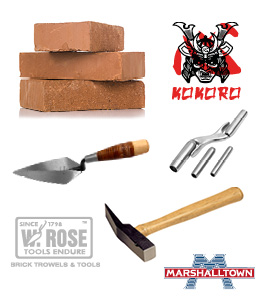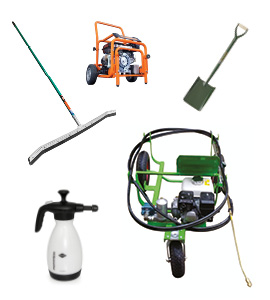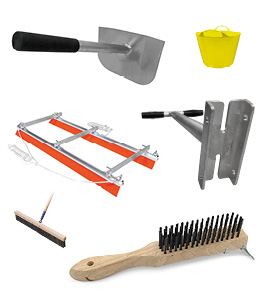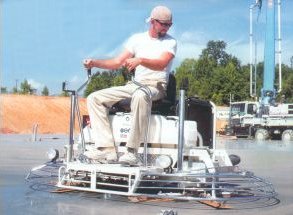
A power float is a concrete finishing machine designed to smooth and to some degree level the surface of the concrete to an exceptionally high tolerance.
For the best results a power float, can finish your concrete to an exceptionally flat, hard and durable surface.
Slight low and high spots can be levelled by the operation of the float, but the concrete should be laid, levelled and compacted using vibration before a float is used. The vibration provides removal of air, which is essential for concrete to achieve full strength and therefore durability.
Power float Options
A key requirement for a power float is its ability to operate reliably and be perfectly balanced. Powerfloats provide a simple method of ensuring that the blades are level and a quick and easy method of adjustment if they become out of line. Floats with poorly aligned blades become unstable, and will make it impossible for the operator to achieve a high tolerance finish.
Our Power floats are available as either petrol or the new diesel option. Engine options vary depending on the size of the float and fuel option. Typically engine sizes vary between 5-10 HP for pedestrian floats to 20-25HP for the larger ride on models.
Floats are available in various sizes. The most popular sizes are:
|
diameter |
suitable for |
|
24” / 0.6 mtr |
Edging float used for working through tight areas i.e. doorways in finished buildings |
|
36” / 09 mtr |
Standard float used in typical applications such as factories, warehouses, airport hangars, etc |
|
46” / 1.2 mtr |
large floor areas such as warehouses where high quality finish is required |
BS and European safety standards are becoming ever tighter and regulate a multitude of features available on the float. Triple guard rings, engine cutout switches, and electrical protection are fitted as standard and Speedcrete are committed in providing safe and reliable machines.
Blade Selection
Floats can be fitted with a variety of blades or pans depending upon the application.|
Floating: |
||
|
|
float blades |
used first for floating |
|
float pan |
alternative to float blades |
|
|
Finishing: |
||
|
finish blades |
used for two or more passes for final finish |
|
|
Combined: |
||
|
combination blades |
one side used for floating, the other side for finishing |
|
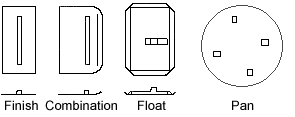
Typically, a pan is used as this simply locks under the finish blades and then is removed for final floating.
Combination blades are normally only used on small contracts where a high quality finish is required but not ‘super flat’ finish would be needed. Using two types of blade usually ends up cheaper.
Timing & Methods
It is essential that the floating is started at the correct time. The operator must wait until the concrete is hard enough to hold the weight of the float and the operator.
A useful mark when considering when to begin is when the operator leaves about 3mm footprints when standing upon the surface. This is because if the concrete is too wet the machine will simply tear up the surface and indeed if it is too dry the machine will not be able to trim high spots and fill lows effectively.
As discussed in the blade choice there are typically two stages to a complete job.
Stage 1: Floating The float is fitted with either float blades or a float pan. In the example below floating starts at the top of the slab and moves top to bottom. The operator walks backwards and thus the float removes any footprints of the operator. The slab should be given an initial pass and the speed should be consistent and slow.
The float blades for this stage should be flat to create suction between float blade and concrete surface. At this stage circular marks will be left on the surface. These should not be light marks, and will be removed on the second stage. The float should pass over any form work in place to ensure level joints.
Stage 2: Finishing Once the surface has been 'floated', the blades of the float are changed or the floating pan is simply removed to reveal the finishing blades. The finishing stage should be started when the surface has dried, and walking over the surface leaves no indents. A good gauge is when the operator can place his hand on the concrete surface and cement is not left on his hand.
For the finishing pass the blades are angled to suit the concrete, increasing the angle after each pass - an angle of around 5-10º is usual, the steeper the angle the harder the finish. Several passes with the finish blades may be required to achieve the specified finish.
Caution!
Extreme care must be taken at both stages of floating to ensure that all areas of the concrete are covered by the float. In most cases hand floating the edges, joints around obstructions and at walls should be done prior to floating. Speedcrete provides a variety of tools for this purpose. This ensures that no large high spots are evident as the power float will not take off excessively large high points is the bay.
Where tolerance is critical, either our lightweight or heavy duty Bumpcutter should be passed over the surface to trim high spots and to aid quicker completion of the job.
A warmish dry day with slight wind yields an ideal curing environment. As you are probably aware a cold wet day is not recommended for laying concrete but sometimes unavoidable!
There is no substitute for good quality concrete, care in preparing the formwork, correct compaction, initial levelling and care and patience in the final finishing of all the surface area.
Please browse our products section for details of tools that perform these jobs.


